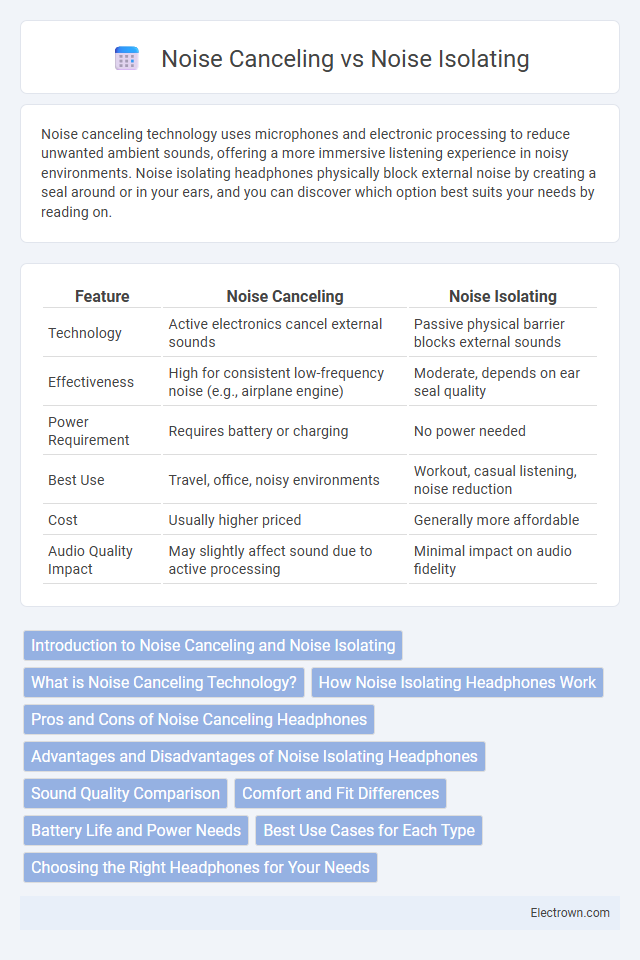Noise canceling technology uses microphones and electronic processing to reduce unwanted ambient sounds, offering a more immersive listening experience in noisy environments. Noise isolating headphones physically block external noise by creating a seal around or in your ears, and you can discover which option best suits your needs by reading on.
Table of Comparison
| Feature | Noise Canceling | Noise Isolating |
|---|---|---|
| Technology | Active electronics cancel external sounds | Passive physical barrier blocks external sounds |
| Effectiveness | High for consistent low-frequency noise (e.g., airplane engine) | Moderate, depends on ear seal quality |
| Power Requirement | Requires battery or charging | No power needed |
| Best Use | Travel, office, noisy environments | Workout, casual listening, noise reduction |
| Cost | Usually higher priced | Generally more affordable |
| Audio Quality Impact | May slightly affect sound due to active processing | Minimal impact on audio fidelity |
Introduction to Noise Canceling and Noise Isolating
Noise canceling technology uses advanced microphones and electronic processing to actively reduce ambient sounds, providing a quieter listening experience. Noise isolating relies on physical barriers like snug-fitting ear tips or headphones to block external noise passively. Your choice between these depends on whether you prefer electronic noise suppression or simply want a seal that blocks distractions naturally.
What is Noise Canceling Technology?
Noise canceling technology uses advanced microphones and electronic processing to detect and counteract external sounds by generating inverse sound waves, significantly reducing unwanted ambient noise. This active noise control method improves the listening experience by minimizing distractions, making it ideal for loud environments like airplanes or busy streets. Unlike noise isolating, which relies on physical barriers like ear cushions to block sound passively, noise canceling dynamically adapts to changing noise levels for superior sound clarity.
How Noise Isolating Headphones Work
Noise isolating headphones physically block external sounds by creating a tight seal around or inside your ears, using cushioned ear cups or in-ear tips that fit snugly in the ear canal. This passive method reduces ambient noise by preventing sound waves from reaching the eardrum, allowing you to enjoy clearer audio without electronic interference. Unlike noise canceling technology, noise isolating headphones do not require batteries or circuitry, making them simple and effective for reducing background noise.
Pros and Cons of Noise Canceling Headphones
Noise canceling headphones use active technology to reduce ambient sounds, providing a quieter listening experience ideal for noisy environments like airplanes or busy streets. They offer superior noise reduction but tend to be more expensive and require battery power, which can limit usage time. Potential drawbacks include slight pressure on the ears and occasional audio artifacts due to the noise-canceling circuitry.
Advantages and Disadvantages of Noise Isolating Headphones
Noise isolating headphones physically block external sounds by creating a seal around or in the ear, offering the advantage of passive noise reduction without requiring batteries or electronics. They tend to be more affordable and compatible with all audio devices but may cause discomfort during extended use due to ear pressure or heat buildup. However, their effectiveness is limited against low-frequency ambient noise compared to active noise canceling technology.
Sound Quality Comparison
Noise-canceling headphones use active technology to reduce ambient sounds by generating inverse sound waves, which can sometimes affect audio fidelity, particularly in the bass and overall clarity. Noise-isolating headphones rely on passive physical barriers to block external noise, preserving the natural sound signature and often delivering crisper, more accurate audio reproduction. For audiophiles prioritizing sound quality, noise-isolating designs typically maintain better sound integrity compared to some noise-canceling models that may introduce slight audio distortion.
Comfort and Fit Differences
Noise canceling headphones use advanced microphones and electronic processing to reduce ambient sounds, offering a more adaptive and comfortable listening experience for extended wear. Noise isolating headphones rely on physical barriers like foam or silicone ear tips to block external noise, which can provide a snug but sometimes less comfortable fit for long periods. Your comfort largely depends on ear shape and personal preference, as noise canceling models often feature lighter, over-ear designs while noise isolating types tend to be in-ear for portability and passive noise blocking.
Battery Life and Power Needs
Noise canceling headphones rely on active electronic components to generate sound waves that cancel out ambient noise, resulting in higher battery consumption and shorter usage time compared to noise isolating headphones. Noise isolating headphones use passive materials like foam or silicone to block external sounds, requiring no power and therefore offering unlimited battery life. Users seeking long-lasting performance without frequent recharging should prioritize noise isolating models, while those valuing advanced noise reduction features must consider the trade-off in battery life inherent to noise canceling technology.
Best Use Cases for Each Type
Noise canceling headphones excel in environments with consistent, low-frequency sounds like airplane cabins or busy offices, providing superior comfort for travel and work by electronically reducing ambient noise. Noise isolating headphones are ideal for blocking out sudden, high-frequency noises, making them perfect for loud settings such as gyms or construction sites by physically sealing your ears from external sounds. Your choice depends on whether you need active technology to minimize constant background noise or passive insulation to protect against sharp, irregular sounds.
Choosing the Right Headphones for Your Needs
Noise canceling headphones utilize advanced microphones and electronic processing to reduce ambient sounds, making them ideal for noisy environments like airplanes or busy offices. Noise isolating headphones rely on physical barriers such as ear pads or in-ear tips to block out sound, offering passive noise reduction that works well in moderately noisy settings. Choose noise canceling if you require active suppression of diverse background noises, but opt for noise isolating headphones when comfort, battery life, and simplicity are your priorities.
noise canceling vs noise isolating Infographic

 electrown.com
electrown.com